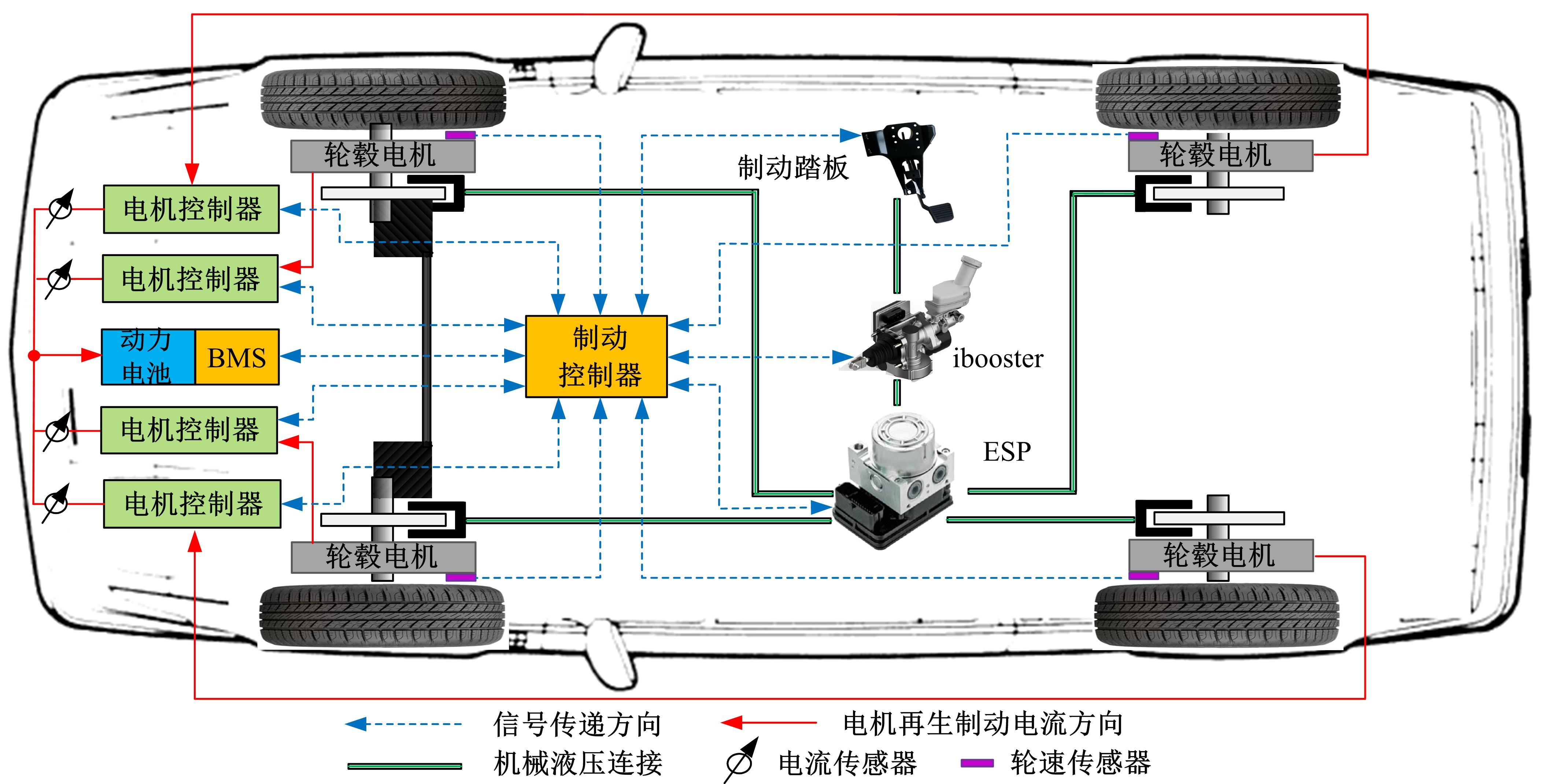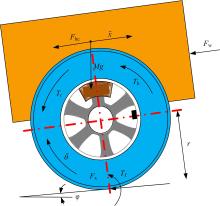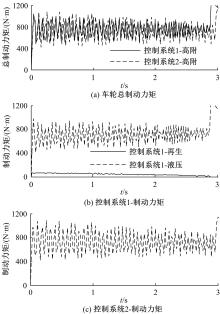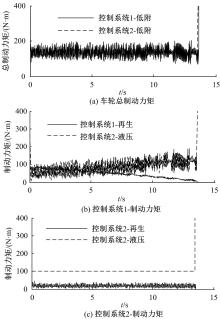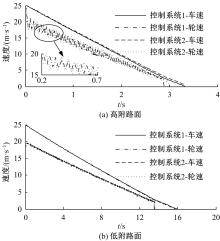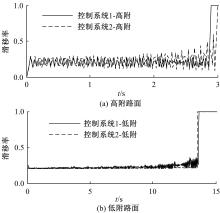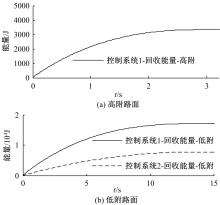Journal of Jilin University(Engineering and Technology Edition) ›› 2022, Vol. 52 ›› Issue (8): 1751-1758.doi: 10.13229/j.cnki.jdxbgxb20210150
Optimal sliding mode ABS control for electro⁃hydraulic composite braking of distributed driven electric vehicle
Jun-cheng WANG1( ),Lin-feng LYU1,Jian-min LI1,Jie-yu REN2
),Lin-feng LYU1,Jian-min LI1,Jie-yu REN2
- 1.School of Mechanical Engineering and Automation,Zhejiang Sci-Tech University,Hangzhou 310018,China
2.Zhejiang Wanxiang Marelli Shock Absorbers,Hangzhou 311200,China
CLC Number:
- U461.3
| 1 | Pang H, Zhang X, Xu Z, et al. Adaptive backstepping-based tracking control design for nonlinear active suspension system with parameter uncertainties and safety constraints[J]. Isa Transactions, 2019, 29(1): 23-36. |
| 2 | 王骏骋, 何仁. 面向全制动工况的液压制动双环预测控制策略[J]. 吉林大学学报: 工学版, 2020, 50(3): 820-833. |
| Wang Jun-cheng, He Ren. Double-loop predictive control scheme of hydraulic braking system using in the all braking conditions[J]. Journal of Jilin University(Engineering and Technology Edition), 2020, 50(3): 820-833. | |
| 3 | Wang J C, He R. Varying charge voltage in steps control method of ABS for in-wheel motors driven electric vehicle based on improved LQG scheme[J]. IEEE Access, 2018, 6: 15039-15050. |
| 4 | Wang C Y, Zhao W Z, Li W. Braking sense consistency strategy of electro-hydraulic composite braking system[J]. Mechanical Systems Signal Processing, 2018, 109: 196-219. |
| 5 | 王骏骋, 何仁. 电动车辆ABS的改进线性二次型最优控制[J]. 哈尔滨工业大学学报, 2018, 50(9): 108-115. |
| Wang Jun-cheng, He Ren. Improved linear quadratic optimal control of ABS for an electric vehicle[J]. Journal of Harbin Institute of Technology, 2018, 50(9): 108-115. | |
| 6 | Heydari S, Fajri P, Sabzehgar R, et al. Optimal brake allocation in electric vehicles for maximizing energy harvesting during braking[J]. IEEE Transacions on Energy Conversion, 2020, 35(4): 1806-1814. |
| 7 | Kunagone K, Werachet K N. Performance evaluation of regenerative braking system based on a HESS in extended range BEV[J]. Journal of Electrical Engineering and Technology, 2018, 13(5): 1965-1977. |
| 8 | 余卓平, 史彪飞, 熊璐, 等. 集成式电子液压制动系统的复合制动协调控制[J]. 同济大学学报: 自然科学版, 2019, 47(6): 851-856. |
| Yu Zhuo-ping, Shi Biao-fei, Xiong Lu, et al. Coordinated control of hybrid braking based on integrated-electric-hydraulic brake system[J]. Journal of Tongji University(Natural Science), 2019, 47(6): 851-856. | |
| 9 | 马金麟, 王新飞, 张厚忠, 等. 电动轮汽车电液复合制动方向稳定性分层控制[J]. 汽车工程, 2019, 41(3): 320-326. |
| Ma Jin-lin, Wang Xin-fei, Zhang Hou-zhong, et al. A study on hierarchical control of directional stability of electric-wheel vehicle with electro-hydraulic braking[J]. Automotive Engineering,2019,41(3):320-326. | |
| 10 | 潘宁, 于良耀, 张雷, 等. 电液复合制动系统防抱控制的舒适性[J]. 浙江大学学报: 工学版, 2017, 51(1): 9-16. |
| Pan Ning, Yu Liang-yao, Zhang Lei, et al. Anti-lock braking control in coordinated braking system considering braking comfort[J]. Journal of Zhejiang University(Engineering Science), 2017, 51(1): 9-16. | |
| 11 | 王骏骋, 何仁. 电动轮轮内主动减振器的非线性最优滑模模糊控制[J]. 汽车工程, 2018, 40(6): 719-725. |
| Wang Jun-cheng, He Ren. Nonlinear optimal sliding mode fuzzy control for in-wheel active vibration damper of electric wheel[J]. Automotive Engineering, 2018, 40(6): 719-725. | |
| 12 | Wang J C, He R, Kim Y B. Optimal anti-lock braking control with nonlinear variable voltage charging scheme for an electric vehicle[J]. IEEE Transactions on Vehicular Technology, 2020, 69(7): 7211-7222. |
| 13 | 余卓平, 左建令, 陈慧. 基于四轮轮边驱动电动车的路面附着系数估算方法[J]. 汽车工程, 2007, 29(2): 141-145. |
| Yu Zhuo-ping, Zuo Jian-ling, Chen Hui. Tire-road friction coefficient estimation with four wheel in-wheel-motor drive vehicle[J]. Automotive Engineering, 2007, 29(2): 141-145. | |
| 14 | 李静, 石求军, 刘鹏, 等. 基于纵向车速估算的商用车ABS神经网络滑模控制[J]. 吉林大学学报: 工学版, 2019, 49(4): 1017-1025. |
| Li Jing, Shi Qiu-jun, Liu Peng, et al. Neural network sliding mode control of commercial vehicle ABS based on longitudinal vehicle speed estimation[J]. Journal of Jilin University(Engineering and Technology Edition), 2019, 49(4): 1017-1025. | |
| 15 | 王骏骋,何仁.轮毂电机电动汽车的变压充电再生制动控制[J].机械工程学报, 2020, 56(10): 181-190. |
| Wang Jun-cheng, He Ren. Voltage variable charging regenerative braking control strategy for in-wheel motors driven vehicle[J]. Journal of Mechanical Engineering, 2020, 56(10): 181-190. | |
| 16 | 张雷, 于良耀, 宋健, 等. 电动汽车再生制动与液压制动防抱死协调控制[J]. 清华大学学报: 工学版, 2016, 56(2): 152-159. |
| Zhang Lei, Yu Liang-yao, Song Jian, et al. Coordinated anti-lock braking control of regenerative and hydraulic braking systems in electric vehicles[J]. Journal of Tsinghua University(Science and Technology), 2016, 56(2): 152-159. |
| [1] | Han-wu LIU,Yu-long LEI,Xiao-feng YIN,Yao FU,Xing-zhong LI. Multi⁃point control strategy optimization for auxiliary power unit of range⁃extended electric vehicle [J]. Journal of Jilin University(Engineering and Technology Edition), 2022, 52(8): 1741-1750. |
| [2] | Qing GAO,Hao-dong WANG,Yu-bin LIU,Shi JIN,Yu CHEN. Experimental analysis on spray mode of power battery emergency cooling [J]. Journal of Jilin University(Engineering and Technology Edition), 2022, 52(8): 1733-1740. |
| [3] | Hong-bo YANG,Wen-ku SHI,Zhi-yong CHEN,Nian-cheng GUO,Yan-yan ZHAO. Optimization of tooth surface modification based on a two-stage reduction gear system [J]. Journal of Jilin University(Engineering and Technology Edition), 2022, 52(7): 1541-1551. |
| [4] | Guang-ming NIE,Bo XIE,Yan-tao TIAN. Design of cooperative adaptive cruise control algorithm based on Frenet framework [J]. Journal of Jilin University(Engineering and Technology Edition), 2022, 52(7): 1687-1695. |
| [5] | Jia-xu ZHANG,Chong GUO,Chen WANG,Jian ZHAO,Xin-zhi WANG. Performance evaluation of automatic parking system based on hardware in the loop simulation platform [J]. Journal of Jilin University(Engineering and Technology Edition), 2022, 52(7): 1552-1560. |
| [6] | Shuai HAO,Chuan-tai CHENG,Jun-nian WANG,Jun-yuan ZHANG,You YU. Ergonomic optimization and test evaluation of sports SUV cockpit layout design [J]. Journal of Jilin University(Engineering and Technology Edition), 2022, 52(7): 1477-1488. |
| [7] | Chen HUA,Run-xin NIU,Biao YU. Methods and applications of ground vehicle mobility evaluation [J]. Journal of Jilin University(Engineering and Technology Edition), 2022, 52(6): 1229-1244. |
| [8] | Xiong LI,Feng-chong LAN,Ji-qing CHEN,Fang TONG. Comparison of injuries in front impact between Hybird III dummy model and CHUBM human biomechanical model [J]. Journal of Jilin University(Engineering and Technology Edition), 2022, 52(6): 1264-1272. |
| [9] | Ying-chao ZHANG,Yun-hang LI,Zi-yu GUO,Guo-hua WANG,Zhe ZHANG,Chang SU. Optimization of the aerodynamic drag reduction of a cab behind engine vehicle [J]. Journal of Jilin University(Engineering and Technology Edition), 2022, 52(4): 745-753. |
| [10] | Wen-ku SHI,Shu-guang ZHANG,You-kun ZHANG,Zhi-yong CHEN,Yi-fei JIANG,Bin-bin LIN. Parameter identification of magnetorheological damper model with modified seagull optimization algorithm [J]. Journal of Jilin University(Engineering and Technology Edition), 2022, 52(4): 764-772. |
| [11] | Jie LI,Tao CHEN,Wen-cui GUO,Qi ZHAO. Pseudo excitation method of vehicle non-stationary random vibration in space domain and its application [J]. Journal of Jilin University(Engineering and Technology Edition), 2022, 52(4): 738-744. |
| [12] | Wei LI,Hai-sheng SONG,Hao-yu LU,Wen-ku SHI,Qiang WANG,Xiao-jun WANG. Linear identification method of hysteresis characteristic of composite leaf springs [J]. Journal of Jilin University(Engineering and Technology Edition), 2022, 52(4): 829-836. |
| [13] | Wei-min ZHUANG,Shen CHEN,Di WU. Influence of strengthening form of CFRP on transverse impact performance of steel tube [J]. Journal of Jilin University(Engineering and Technology Edition), 2022, 52(4): 819-828. |
| [14] | Liang DUAN,Chun-yuan SONG,Chao LIU,Wei WEI,Cheng-ji LYU. State recognition in bearing temperature of high-speed train based on machine learning algorithms [J]. Journal of Jilin University(Engineering and Technology Edition), 2022, 52(1): 53-62. |
| [15] | Wei-min ZHUANG,Shen CHEN,Nan WANG. Influence on thermal stress of autobody steel-aluminum clinch-adhesive connection structure [J]. Journal of Jilin University(Engineering and Technology Edition), 2022, 52(1): 70-78. |
|
||

